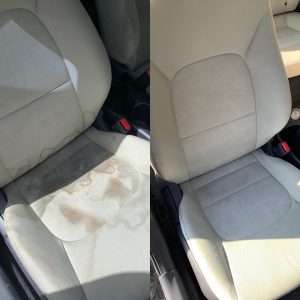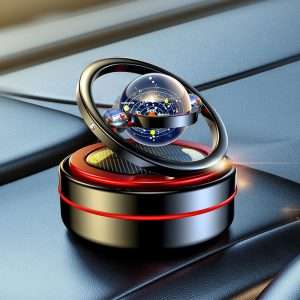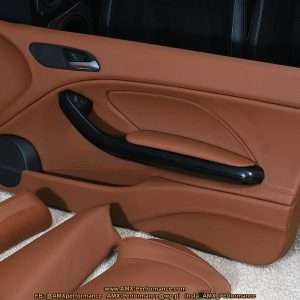Understanding the Problem
A sagging car roof liner is a common issue, especially in older vehicles or those exposed to high temperatures. The adhesive holding the fabric to the headliner board deteriorates over time. This causes the fabric to detach and droop. It’s unsightly and can be distracting while driving. Fortunately, you can often fix it yourself with the right tools and a bit of patience. This guide will walk you through the process.
Gathering Your Supplies
Before you start, make sure you have everything you need. Having the right tools will make the job much easier. Here’s a list of essential supplies:
- New headliner fabric (slightly larger than your headliner board)
- Headliner adhesive spray (high-temperature resistant)
- A stiff brush or scraper
- Screwdrivers and socket set (for removing trim)
- Scissors or a utility knife
- Gloves and a mask (for working with adhesive)
- Optional: Heat gun (for stubborn adhesive)
Tip: Choose a headliner fabric that matches your car’s interior. Consider the color and texture for a seamless look. You can find headliner fabric at most auto parts stores or online retailers.
Removing the Headliner Board
This is often the most challenging part of the process. You’ll need to carefully remove the trim pieces around the headliner. This includes sun visors, dome lights, grab handles, and any other components holding it in place. Take pictures as you go so you remember where everything goes when you reassemble it. Gently lower the headliner board out of the car. Be careful not to bend or break it.
Important: Disconnect the car battery before removing any electrical components. This will prevent accidental shorts and damage to your car’s electrical system.
Cleaning and Preparing the Headliner Board
Once the headliner board is out, remove the old fabric. Use a stiff brush or scraper to remove all the old adhesive and foam backing. This is crucial for a smooth and even application of the new fabric. A clean surface ensures a strong bond. Take your time and be thorough.
Applying the New Fabric
Lay the new headliner fabric over the board. Make sure it’s centered and has enough overlap on all sides. Spray a section of the board with headliner adhesive. Then, carefully smooth the fabric onto the adhesive. Work in small sections to avoid wrinkles and bubbles. Use your hands to press the fabric firmly onto the board. Repeat this process until the entire board is covered. Trim the excess fabric around the edges.
Reinstalling the Headliner Board
Carefully lift the headliner board back into the car. Reattach all the trim pieces you removed earlier. Refer to the pictures you took during disassembly to ensure everything is in the correct place. Reconnect the car battery. Test all the electrical components to make sure they are working properly.
FAQ ౼ Frequently Asked Questions
Alternative Repair Methods
While replacing the entire headliner is the most thorough solution, there are alternative methods for addressing minor sagging. These methods are often quicker and less expensive, but they may not provide a long-lasting fix. Consider these options if the sagging is localized or you’re on a tight budget.
Using Headliner Glue in a Syringe
For small, isolated areas of sagging, you can inject headliner adhesive directly behind the fabric. Use a syringe with a needle to carefully inject the glue. Press the fabric against the headliner board and hold it in place until the adhesive dries. This method is best for small areas and may not be effective for large-scale sagging.
Headliner Repair Pins or Screws
Another option is to use headliner repair pins or screws. These are small fasteners that attach the fabric to the headliner board. They are relatively easy to install and can provide a quick fix. However, they may be visible and can detract from the overall appearance of the interior. They also might damage the headliner board if not installed carefully.
Steaming the Headliner
In some cases, steaming the headliner can help to re-activate the adhesive. Use a fabric steamer to gently steam the sagging areas. Be careful not to over-saturate the fabric. This method works best when the adhesive is only slightly deteriorated. It’s a gamble, but sometimes it works!
Important Note: These alternative methods are temporary fixes; They may not last as long as replacing the entire headliner. If the sagging is extensive, replacing the headliner is the best long-term solution.
Preventing Future Sagging
Once you’ve fixed your car’s headliner, you’ll want to take steps to prevent it from sagging again. Here are some tips to help prolong the life of your headliner:
- Park in the shade: Exposure to direct sunlight can accelerate the deterioration of the adhesive.
- Use a sunshade: A sunshade can help to reduce the temperature inside your car.
- Ventilate your car: Open the windows slightly to allow hot air to escape.
- Avoid using harsh chemicals: When cleaning your car’s interior, avoid using harsh chemicals that can damage the headliner fabric.
By following these tips, you can help to keep your car’s headliner looking its best for years to come. It’s a small price to pay for a much better looking interior;
Professional Installation
If you’re not comfortable tackling this project yourself, you can always hire a professional to replace your car’s headliner. A professional installer will have the experience and tools necessary to do the job quickly and efficiently. While it will cost more than doing it yourself, you can be sure that the job will be done right. It’s a good option if you lack the time or confidence to do it yourself.
Choosing the Right Fabric
Selecting the right fabric is crucial for a successful headliner repair. The original fabric is often a thin, foam-backed material specifically designed for headliners. You’ll want to find a replacement that is as close as possible in terms of weight, texture, and color. Using the wrong fabric can lead to poor adhesion, an uneven finish, and a headliner that doesn’t look quite right.
Types of Headliner Fabric
- Foam-backed headliner fabric: This is the most common type of headliner fabric. It consists of a thin layer of fabric laminated to a foam backing. The foam provides cushioning and helps to absorb sound.
- Suede headliner fabric: Suede is a luxurious option that adds a touch of elegance to your car’s interior. However, it can be more difficult to work with and may require special adhesive.
- Vinyl headliner fabric: Vinyl is a durable and easy-to-clean option. It’s a good choice for vehicles that are exposed to a lot of wear and tear.
Consider the color of your car’s interior when choosing a fabric. You’ll want to select a color that complements the existing trim and upholstery. You can usually find headliner fabric at auto upholstery shops or online retailers. Be sure to order enough fabric to cover the entire headliner board, with some extra for trimming.
Tip: Order a sample of the fabric before you buy it to ensure that it matches your car’s interior and that you like the texture and feel.
Tools and Materials You’ll Need
Before you start your headliner repair, gather all the necessary tools and materials. Having everything on hand will make the process much smoother and more efficient. Here’s a list of essential items:
- New headliner fabric: Enough to cover the entire headliner board.
- Headliner adhesive: A high-quality spray adhesive specifically designed for headliners.
- Stiff brush or scraper: For removing old adhesive and foam backing.
- Screwdrivers and sockets: For removing trim pieces.
- Pliers: For removing clips and fasteners.
- Scissors or utility knife: For trimming the fabric.
- Measuring tape: For measuring the headliner board.
- Safety glasses: To protect your eyes from debris and adhesive.
- Gloves: To protect your hands from adhesive.
- Drop cloth or plastic sheeting: To protect your car’s interior.
- Heat gun (optional): For softening stubborn adhesive.
Make sure you have a well-ventilated workspace. Headliner adhesive can be strong and potentially harmful, so it’s important to work in an area with good airflow. A garage or outdoor space is ideal.
Troubleshooting Common Problems
Even with careful preparation, you may encounter some problems during your headliner repair. Here are some common issues and how to address them:
Wrinkles and Bubbles
Wrinkles and bubbles can occur if the fabric is not applied smoothly or if the adhesive is not evenly distributed. To fix wrinkles, gently peel back the fabric and reapply it, smoothing out the wrinkles as you go. For bubbles, use a needle to puncture the bubble and then press the fabric down to release the air.
Adhesive Failure
Adhesive failure can occur if the surface is not properly cleaned or if the wrong type of adhesive is used. Make sure to thoroughly clean the headliner board before applying the new fabric. Use a high-quality headliner adhesive that is designed to withstand high temperatures.
Sagging
Sagging can occur if the fabric is not properly adhered to the headliner board. Make sure to apply the adhesive evenly and press the fabric firmly onto the board. If sagging occurs after the repair, you may need to reapply the adhesive or use headliner repair pins.
Pro Tip: If you’re having trouble getting the fabric to adhere properly, try using a heat gun to warm the adhesive. This can help to activate the adhesive and create a stronger bond.




